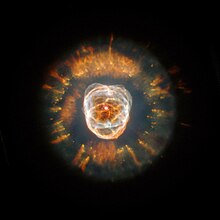Kompaktní hvězda

Kompaktní hvězda je termín užívaný v astronomii pro objekty s vysokou hustotou jako bílé trpaslíky, neutronové hvězdy, černé díry a další exotické pevné hvězdy.
Většina kompaktních hvězd je v závěrečném stádiu hvězdného vývoje a jsou tak označovány jako hvězdné zbytky. Tento zbytek závisí hlavně na původní hmotnosti dané hvězdy. Tyto hvězdy mají velmi velkou hustotu. Jsou totiž navzdory své malé velikosti velmi těžké. Termín kompaktní hvězda se často užívá pro hvězdy, u kterých neznáme přesnou povahu a zároveň má malý poloměr. Všechny kompaktní hvězdy, kromě černé díry, mohou být též nazývány jako degenerované hvězdy.
Kompaktní hvězdy jako konečný bod hvězdného vývoje
Kompaktní hvězdy jsou obvykle koncovým bodem hvězdného vývoje. Atomy vodíku pod nesmírným tlakem gravitační síly hvězdy projdou jadernou fúzí, čímž se snižuje hmotnost a velikost hvězdy. Ve snaze ochladit se, hvězda vyzařuje světelnou energii. Tato ztráta hmotnosti a energie způsobuje snížení gravitační potenciální energie. Hvězda se zmenšuje a zároveň zvyšuje vnitřní gravitační sílu, která zpočátku způsobila jadernou fúzi. Tento cyklus pokračuje do doby, kdy tlak plynu v horkých místech již neunese váhu hvězdy. Hvězda tak získá jevem, kterému se říká hvězdný kolaps, mnohem větší hustotu. Kompaktní hvězdy sice neumí vnitřně vytvářet energii, avšak mohou vyzařovat světlo z přebytečného tepla ještě miliony let od hvězdného kolapsu.
Média použitá na této stránce
Eskimo nebula (NGC 2392). In its first glimpse of the heavens following the successful December 1999 servicing mission, NASA's Hubble Space Telescope captured a majestic view of a planetary nebula, the glowing remains of a dying, Sun-like star. This stellar relic, first spied by William Herschel in 1787, is nicknamed the "Eskimo" Nebula (NGC 2392) because, when viewed through ground-based telescopes, it resembles a face surrounded by a fur parka.
In this Hubble telescope image, the "parka" is really a disk of material embellished with a ring of comet-shaped objects, with their tails streaming away from the central, dying star. The Eskimo's "face" also contains some fascinating details. Although this bright central region resembles a ball of twine, it is, in reality, a bubble of material being blown into space by the central star's intense "wind" of high-speed material.
In this photo, one bubble lies in front of the other, obscuring part of the second lobe. Scientists believe that a ring of dense material around the star's equator, ejected during its red giant phase, created the nebula's shape. The bubbles are not smooth like balloons but have filaments of denser matter. Each bubble is about 1 light-year long and about half a light-year wide.
Scientists are still puzzled about the origin of the comet-shaped features in the "parka." One possible explanation is that these objects formed from a collision of slow-and fast-moving gases.
The Eskimo Nebula is more than 2,870 light-years from Earth in the constellation Gemini. The picture was taken Jan. 10 and 11, 2000, with the Wide Field and Planetary Camera 2. The nebula's glowing gases produce the colors in this image: nitrogen (red), hydrogen (green), oxygen (blue), and helium (violet).